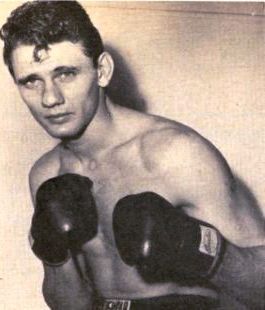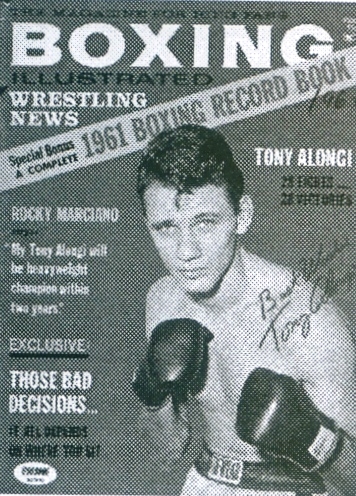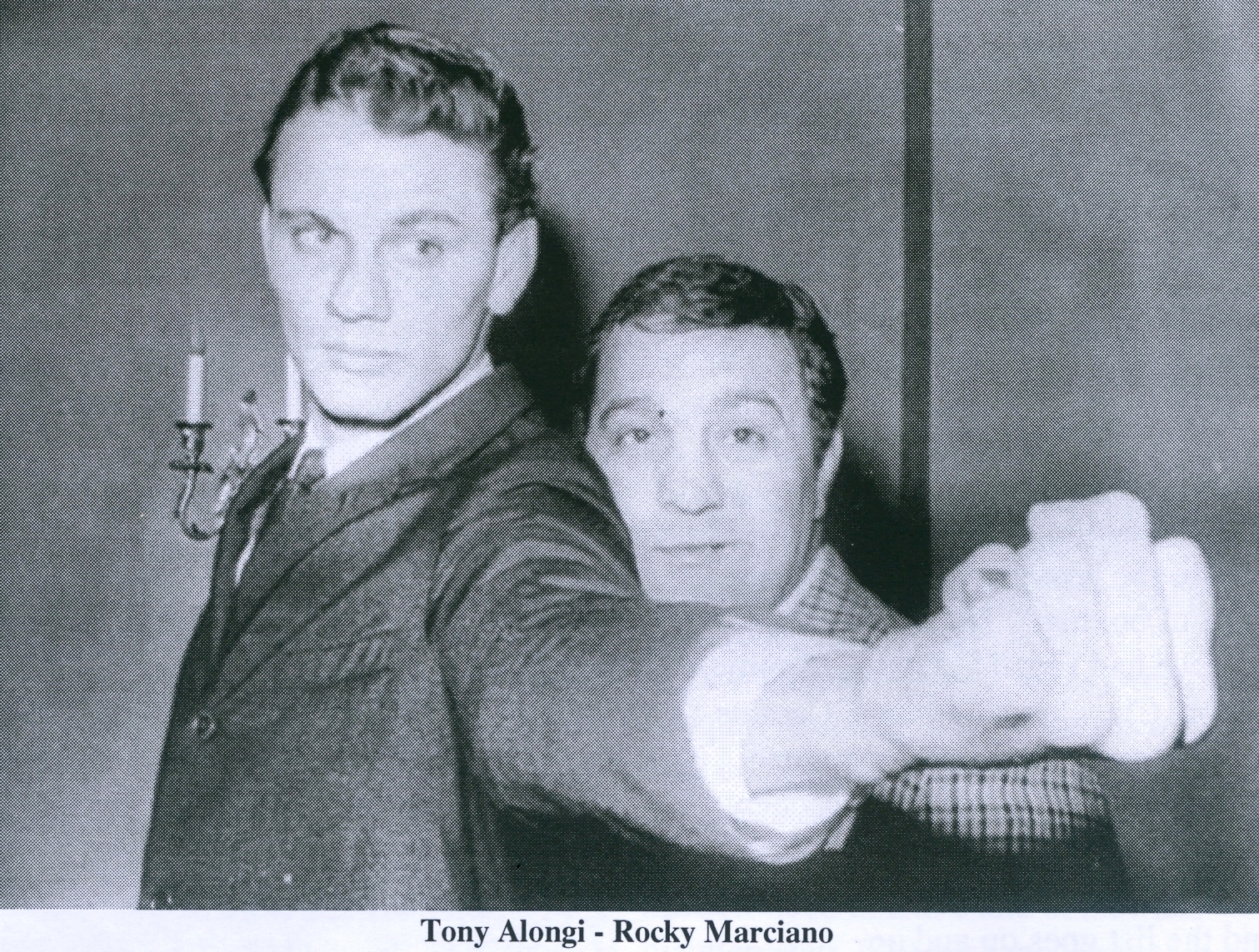SJC
HOME
FIGHTERS
BOXING FOR FITNESS & AMATEUR INFO
STEVE'S CORNER
BIOS
PROFILES
PICTURES
VIDEOS
LINKS
EMAIL
TONY ALONGI: A FORGOTTEN HEAVYWEIGHT
By Steven J. Canton, February 4, 2013
(Originally published in THE BOXING WORLD, March 2013)

The early 1960s was an exciting time in the world of professional boxing. There were many great fighters and great fights, unlike today’s era. In particular, the heavyweight division was outstanding. They used to say, “As go the heavyweights, so goes the sport of boxing.” No wonder, at that time we had Floyd Patterson, Sonny Liston, Cleveland Williams, Cassius Clay (soon to become Muhammad Ali), Henry Cooper, Eddie Machen, Ingemar Johansson, Zora Folley, Jerry Quarry, George Chuvalo, Doug Jones, and the list goes on and on.
The sport was different then. The best fighters all fought each other…and wanted to. We had one world champion in each weight class and everyone not only knew who all the Champions were, but also, the top contenders. Title fights were 15 rounds, not 12. Most of the major newspapers had boxing writers and we had regular boxing telecasts on network television, including the iconic Friday night Gillette Cavalcade of Sports.
In the lower weight classes we had Archie Moore, Sugar Ray Robinson, Emile Griffith, Dick Tiger, Carlos Ortiz, Gene Fullmer, Carmen Basilio and several other magical names of the sweet science. Boxing was a mainstream sport then and what other sports aspired to be.
 Somehow, Tony Alongi, one of the better heavyweights of that era, is almost forgotten today. But, he was the most exciting fighter and number 1 drawing card for promoter Chris Dundee, in Miami. He graced the cover of several boxing magazines, and was often showcased and featured in the sports sections of newspapers all over the country.
Somehow, Tony Alongi, one of the better heavyweights of that era, is almost forgotten today. But, he was the most exciting fighter and number 1 drawing card for promoter Chris Dundee, in Miami. He graced the cover of several boxing magazines, and was often showcased and featured in the sports sections of newspapers all over the country.
Tony was born on August 31, 1939, in Passaic, New Jersey. As a teenager, he developed a love for boxing and his favorite fighter was Rocky Marciano. He dreamed of a professional career, winning the heavyweight championship of the world, and then retiring undefeated, as Marciano did.
He began boxing in 1955, at the age of 16, and was immediately successful. He was on his way toward realizing his dreams, as he won the New Jersey Golden Gloves championships in both 1956 and 1957 and completed his amateur career with an undefeated record of 27-0, with 12 knockouts. Now it was time to turn professional and fulfill his dreams.
 In a script almost too good for Hollywood, he signed on with famed trainer Charlie Goldman (who had trained Marciano) and became the protégé of the Rock. His debut was in Miami Beach on February 24, 1959 with a decision victory over Tiger Lee Flowers. He fought 8 more times that year and finished his first year as a professional 9-0, with 5 K.O.’s.
In a script almost too good for Hollywood, he signed on with famed trainer Charlie Goldman (who had trained Marciano) and became the protégé of the Rock. His debut was in Miami Beach on February 24, 1959 with a decision victory over Tiger Lee Flowers. He fought 8 more times that year and finished his first year as a professional 9-0, with 5 K.O.’s.
Tony continued his busy pace in 1960, fighting 12 times and he remained undefeated, including 8 more knockout victories. As 1961 unfolded he stepped up the quality of opposition, winning all 7 of his bouts that year; including wins over 4 undefeated fighters, among them the hard hitting Texan Todd Herring, and the highly regarded Jefferson Davis. Herring was expected to overcome Alongi’s boxing skills, and win going away, but was stopped in round 8. Alongi’s win over the tough Jefferson Davis propelled him into a national televised date against George Logan, who was ranked 8th in the world at the time. That fight took place at Madison Square Garden, and Alongi dominated, winning a one-sided decision. He was now 28-0, with 16 K.O.’s., and a title fight seemed to be on the horizon.
However, a controversy in his next fight, February 7, 1962, against Rodolfo Diaz, the Argentine light heavyweight champ, resulted in Alongi’s first defeat, and derailed his storybook career. He entered the ring rated #6 in the world and built up a big lead, scoring repeatedly with his vaunted left jab and was boxing smartly. He was caught with a counter right hand and left hook in the 6th round and his left eye immediately began to swell. In the following round, a head butt all but closed the eye and it was difficult for him to see. However, he was still holding his own until suddenly in the 10th and final round, with only 26 seconds to go, referee Dave Fields jumped in and stopped the fight. Alongi was well ahead on the scorecards, and would have handily won the decision. His trainer, Charlie Goldman was irate, saying, “Tony gets headbutted in the 7th round and the referee lets it go all the way to the final round and then stops it with only 26 seconds left. There’s no way Tony could have lost the decision, he was so far ahead.” Alongi’s dream of remaining undefeated was over.
He was out for eight months recuperating from the eye injury before stepping back into the ring against Joey DeGrazio, a popular club fighter in New Jersey, with a 16-2 record. The fight took place at Gladiator’s Arena, in Totowa, New Jersey. Former Light heavyweight Champ Gus Lesnevich was the referee. DeGrazio was predicting an upset, but was no match for the skills of Alongi, who stopped him in round five.
Next up was Billy “The Barber” Daniels, a tough, highly regarded and ranked fighter who was fresh off a TKO win over top ten Mike DeJohn. Daniels’ only loss had been to Cassius Clay via 7th round stoppage, from a cut eye, in a very close and competitive bout only seven months earlier. Daniels was the 2-1 favorite with the winner promised a shot against Cleveland “Big Cat” Williams, who was rated #3.
The bout started well for Alongi, who was the aggressor, landing stiff jabs and right hands to the body. Daniels, who was bothered by the body shots, was forced to back away instead of employing his usual come-forward style. After three rounds, Alongi was in complete control with Daniels bleeding from the nose, bruised under his left eye and completely on the defensive. However, in the fifth, Alongi came out with his hands held a little too low, perhaps a little overconfident, and Daniels took advantage of the opportunity by landing a terrific right hand counter and dropped him. Alongi, who was a little off balance, complained to referee Arthur Mercante that the punch didn’t really knock him down. Nevertheless, it was a legitimate knockdown, and Daniels came alive, pouncing on Alongi with a sustained all-out attack knocking him down two more times and causing a stoppage with only ten seconds left in the round. It seemed that Alongi’s days as a future champion were now over.
However, Alongi launched a successful comeback, and tried to make another run to the top of the mountain. It began five months after the loss to Daniels, as he returned home to the Auditorium in Miami Beach, against Prentice Snipes, a fast punching, confident fighter. Snipes was expected to be a tough test for Alongi, but only lasted until the fourth round before being put away by a right to the body. The dangerous Don Warner was next, a Philadelphia fighter with 16 knockouts in his 17 wins. However, Alongi’s jab was working overtime and he punished Warner throughout, stopping him in the 4th round with an assortment of solid combinations.
A tough nationally televised ”elimination” fight against the Canadian Champ, George Chuvalo, followed and resulted in another controversy. Chuvalo was favored and the fight was a hard-fought bruising battle. Alongi got up from an early knockdown to outbox Chuvalo much of the way. The bout was originally announced as a split decision win for Alongi, but was changed to a draw the following day, by the commission, saying the referee’s scorecard had been added incorrectly. The Associated Press had Alongi a 96-94 winner.
Around this time, Tony developed serious problems with his right elbow caused by bone chips. During 1964 he only fought twice, though he won both bouts, his elbow continued to be a major problem. He was scheduled to face #1 ranked heavyweight Doug Jones in Madison Square Garden on August 14, with the winner to face the new heavyweight champ, Muhammad Ali, but was forced to pull out. The injury kept him out of action for almost a year. Though he “recovered,” he was in constant pain as the elbow was never the same and bothered him throughout the remainder of his career.
 He fought ten more times, winning seven with three draws, before finally retiring in 1967, citing the sore elbow and a loss of vision in his right eye. Two of the draws were against upcoming Jerry Quarry, one at Madison Square Garden, and the other in Quarry’s backyard…Los Angeles, California. His final ring record was an outstanding 40-2-4, with 23 wins coming by way of knockout. Sadly, Tony never did get a title opportunity.
He fought ten more times, winning seven with three draws, before finally retiring in 1967, citing the sore elbow and a loss of vision in his right eye. Two of the draws were against upcoming Jerry Quarry, one at Madison Square Garden, and the other in Quarry’s backyard…Los Angeles, California. His final ring record was an outstanding 40-2-4, with 23 wins coming by way of knockout. Sadly, Tony never did get a title opportunity.
After boxing, Tony lived a quiet and uneventful life in South Florida. He was never bitter. He said, “Everything worked out for the best. It just wasn’t meant to be. I might have become rich and famous and not realized how nice it would be to have a wife and family. I wouldn’t trade my family for all the championships in the world.”
Tony became a devoted husband to wife Cindy and loving father to his four children, Jennifer, Joey, Christa, and Angela. He was always easy-going, with a good sense of humor, and helpful to all.
Alongi was inducted into the New Jersey Boxing Hall of Fame in 1996 and is a candidate for future induction into the Florida Boxing Hall of Fame. It would be well deserved and help keep his legacy alive.
When he died of heart failure on November 27, 2003, at the age of 64, the Miami Herald obituary never even mentioned his great boxing career. Somehow, one of the better heavyweight fighters of his era was even forgotten in death.
BACK FORWARD
Copyright 1998-2021 SJC Professional Boxing, Inc. All Rights Reserved

 Somehow, Tony Alongi, one of the better heavyweights of that era, is almost forgotten today. But, he was the most exciting fighter and number 1 drawing card for promoter Chris Dundee, in Miami. He graced the cover of several boxing magazines, and was often showcased and featured in the sports sections of newspapers all over the country.
Somehow, Tony Alongi, one of the better heavyweights of that era, is almost forgotten today. But, he was the most exciting fighter and number 1 drawing card for promoter Chris Dundee, in Miami. He graced the cover of several boxing magazines, and was often showcased and featured in the sports sections of newspapers all over the country.
 In a script almost too good for Hollywood, he signed on with famed trainer Charlie Goldman (who had trained Marciano) and became the protégé of the Rock. His debut was in Miami Beach on February 24, 1959 with a decision victory over Tiger Lee Flowers. He fought 8 more times that year and finished his first year as a professional 9-0, with 5 K.O.’s.
In a script almost too good for Hollywood, he signed on with famed trainer Charlie Goldman (who had trained Marciano) and became the protégé of the Rock. His debut was in Miami Beach on February 24, 1959 with a decision victory over Tiger Lee Flowers. He fought 8 more times that year and finished his first year as a professional 9-0, with 5 K.O.’s.
 He fought ten more times, winning seven with three draws, before finally retiring in 1967, citing the sore elbow and a loss of vision in his right eye. Two of the draws were against upcoming Jerry Quarry, one at Madison Square Garden, and the other in Quarry’s backyard…Los Angeles, California. His final ring record was an outstanding 40-2-4, with 23 wins coming by way of knockout. Sadly, Tony never did get a title opportunity.
He fought ten more times, winning seven with three draws, before finally retiring in 1967, citing the sore elbow and a loss of vision in his right eye. Two of the draws were against upcoming Jerry Quarry, one at Madison Square Garden, and the other in Quarry’s backyard…Los Angeles, California. His final ring record was an outstanding 40-2-4, with 23 wins coming by way of knockout. Sadly, Tony never did get a title opportunity.